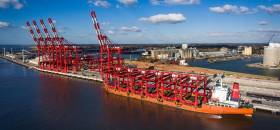Displaying items by tag: Final Giant Cranes
#GiantCranes - The last batch of giant cranes for the Irish Sea's newest container terminal, the £400m Liverpool2 deep-water port development arrived by sea from China onto the River Mersey in recent days.
In May, Afloat reported on the first delivery from China of the cantilever rail-mounted gantry (CRMG) cranes that will be used at the biggest container terminal on the Irish Sea. The facility will cater for larger capacity and deeper-draft containerships.
Mark Whitworth, chief executive of Peel Ports, said: “These cranes are the final major piece of the infrastructure jigsaw as we approach the formal opening next month".
“Liverpool2, supported by our wider logistics offering and the port’s strategic location, will provide many shippers with a route to UK and Irish markets that helps them to cut costs, congestion and carbon emissions.”
The Chinese manufacturer ZPMC, also supplied the five ship-to-shore cranes and other CRMGs already on site, these six complete the set of 12 required for phase 1 of the terminal. Ultimately the site will have eight STS and 22 CRMG cranes as part of a £100m equipment investment.
Each of the cranes will be capable of performing an average of 20 moves per hour, with semi-automated control linked to the port’s new Navis N4 terminal operating system. They have a 40 tonne under-spreader capacity and a maximum container lift height above quay level of 21m under spreader (6+1 containers).
In August the cranes originally set off from Nantong on board the Zhenhua 8, passing south-east Asia, India, the Arabian Peninsula and through the Suez canal en route to Liverpool in a 49 day journey of over 20,000km (13,730 m, 11,930nm).























